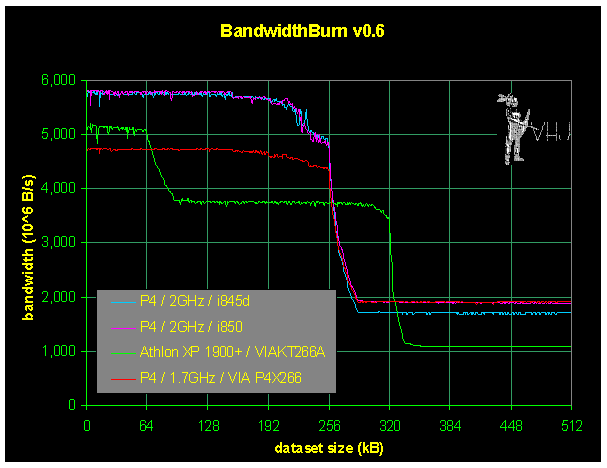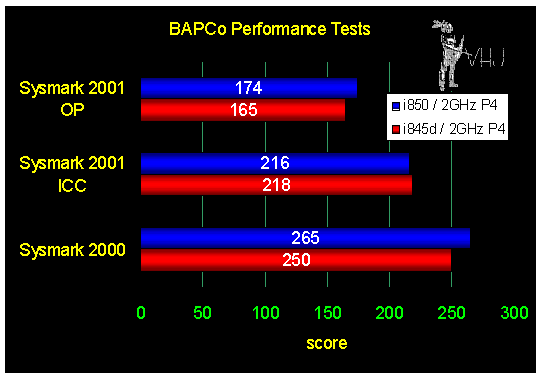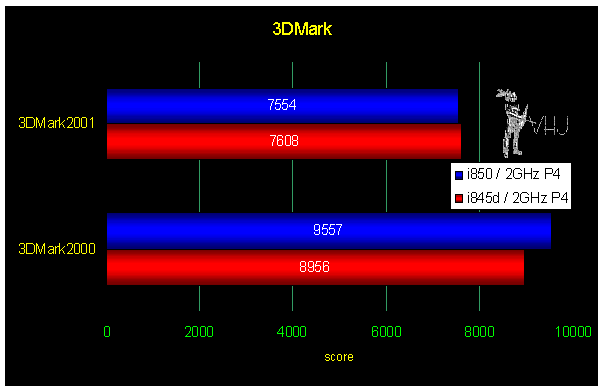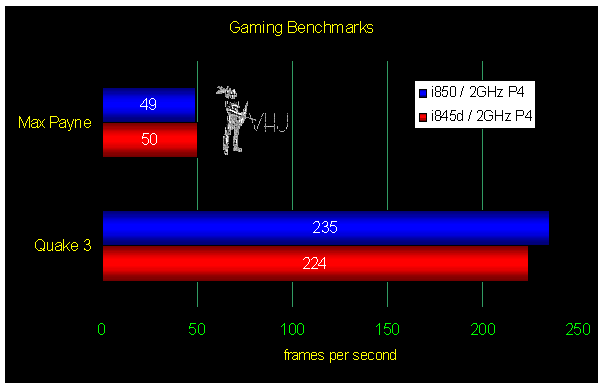
Taking Off the Shackles: The i845 Finally Moves to DDR
By Joel Hruska and Van Smith
Date: January 2, 2002
Since the curtain raised on the
Intel Pentium 4, the chip’s core logic
options have generated almost as much controversy as the processor itself.
Although the P4 proved to offer far better performance when paired with
RDRAM than the Pentium III did, Rambus did itself no favors with its pursuit
of a DRAM monopoly via the court room when its own incredibly expensive
and over-hyped RDRAM technology failed to deliver in 1999-2000. The resultant
mess has left many customers firmly turned off of RDRAM and hence dubious
of a Pentium 4 so equipped. Of course, RDRAM’s continued price premium
over SDRAM has not helped anything either.
Earlier this year Intel introduced the SDRAM version of the i845 chipset
hoping to take advantage of the market’s acceptance of the memory design
and the technology’s much lower price point [ed: of course there is the
question of the infamous Intel-Rambus agreement which inhibited the chip
giant's move to faster DDR SDRAM sooner than 2002]. While this strategy
has been successful at pushing the P4 into the lower end of the market,
the very nature of the older and slower SDRAM interface severely bottlenecked
the P4’s performance, a chip whose saving grace is its impressive bandwidth.
While the cheaper SDRAM-based P4 systems were embraced by OEM’s looking to move
this chip into lower price brackets, the performance oriented section of
the market has firmly rejected the P4+i845 SDRAM as a serious computing solution.
However, with the introduction of the i845B0, better know as the i845d,
Intel may be set to change all that. The i845d is Intel’s first DDR SDRAM
desktop chipset of any kind and offers official support for both PC1600 and PC2100 memory running
asynchronously on a 200 MHz or 266 MHz bus. The major question is, though, will the i845d
prove itself a competitor to the i850, or will the DDR SDRAM incarnation
of the i845 fall flat as the SDRAM version did?
One of the first motherboard companies out of the gate with an i845d board
is MSI. We used this motherboard in our review.
===================================
The MSI 845 Ultra-ARU: A Motherboard
Done Right
The MSI 845 Ultra-ARU is one of the most powerful and well equipped motherboards
on the market today. It ships in these possible configurations (845 Ultra,
Ultra-A, Ultra-RU, Ultra-ARU) each one designed for a different price point and
type of buyer. Our review today is done using an Ultra-ARU board.

Specifications on the MSI 845 Ultra-ARU include:
• Support for Socket 478 Pentium 4’s to above 2.0GHz.
• Support for DDR SDRAM in 200/266 MHz configurations (up to 2 GB)
• 1.5v AGP Pro interface with 4x transfer speeds
• Onboard CMI 8738 Sound
• Two Onboard IDE connections w/ support for ATA100
• Onboard Promise Controller w/support for ATA133 (-A only)
• Onboard Promise RAID Controller w/support for ATA133 (-ARU only)
• 4 Onboard USB Ports (Ultra, Ultra-A)
• 4 Additional Onboard USB 2.0 Ports (Ultra-ARU only)
• 1 AGP / 5 PCI / 1 CNR slot
• D-LED Brackets (LED-based Diagnostic system)
By offering the various versions of their 845 Ultra-ARU board, MSI has positioned itself to appeal to different types of customers. The basic Ultra board offers the features listed above, while the Ultra-A adds the ATA133 compliant Promise IDE ports. The Ultra-ARU offers additional RAID support from the Promise controller (again with ATA133 support) and adds support for the new USB 2.0 standard as well. MSI has clearly covered the market well, with boards available at a variety of price points and aimed at a variety of customers.
===================================
The Memory Bank Issue
One configuration issue not unique to the MSI board, but common to all i845d-based
motherboards boards is that the Intel i845d spec only allows for four banks
of memory to be used on the chipset. Essentially, this means that all i845d
motherboards will have a maximum of two fewer banks of memory than the SDRAM
version of the i845. This translates into a maximum of eight fewer open
pages (16 versus 24), increasing latencies and reducing performance under these
circumstances.
Although the MSI 845 board offers 3 DIMM slots [ed: which is actually one beyond what Intel recommends] the total number of banks used across the entire three slots cannot be greater then four. Four banks can be achieved with two double-sided DIMMs.
Further limiting the i845d is its lack of support for registered DIMMs meaning that serious users needing more than a gigabyte of memory will have to turn to VIA's P4X266 which does handle registered DDR SDRAM DIMMs.
===================================
MSI’s Included Software
Package
MSI includes several software packages designed to add functionality and
additional services to their motherboards. These packages include:
Providing these software solutions demonstrates
a clear dedication to customer care. Rather than just providing a board,
they’ve chosen to provide a set of utilities that make life easier for the
average customer.
Having covered the specifications of the board itself, let’s move on to
its performance. Will the i845D have what it takes to topple the i850 chipset
from its high-performance perch, or will the i850 continue to hold its position
as Intel’s top-performing P4 chipset?
===================================
Test Configuration
P4 2.0 GHz
256 MB Kingston RDRAM / 512 MB Mushkin High Performance DDR
VisionTek GeForce 3 Ti 500
Windows 2000 w/ SP2 Installed
DirectX 8.1 Installed
NVIDIA Detonator 21.83 Drivers
The P4 DDR system was mounted on the 845 Ultra-ARU and the P4 i850 used the MSI 850 Pro 5 board.
===================================
BandwidthBurn
Before we discuss our test results, we will quickly review what a chipset is.
A main board chipset, or core logic controller, typically houses the memory controller, AGP interface, PCI, IDE, audio, and sundry IO controllers. So called integrated chipsets also include graphics cores. Clearly, to fully evaluate a chipset's merits, all of its embedded functionality should be tested.
For our brief review of the i845d, we will focus on the memory controller while also testing general functionality by executing a number of application level benchmarks.
The chipset's memory controller typically has the greatest impact on overall application speed. The two major performance aspects influenced by the memory controller are memory bandwidth and memory latency.
Memory bandwidth is the rate at which data can be transferred from memory. Modern CPU's are beginning to severely outpace the performance of their memory subsystems, so much attention has been given recently to memory bandwidth.
We have recently enhanced our COSBI test for memory bandwidth. BandwidthBurn now extracts much higher transfer rates for cache, while main memory bandwidth has increased for every CPU other than the Intel Pentium 4, which declined by about 10%. This new version of BandwidthBurn will be made available along with the source code in an article to be delivered next week.

The graph above shows L1, L2 and main memory bandwidth. The Pentium 4 has an inclusive architecture demonstrated clearly by the sharp decline in bandwidth at 256kB, the size of the P4's L2 cache. The impact of the tiny 8kB L1 cache cannot be seen, although Athlon XP's massive 64kb L1 d-cache is plainly visible. Overall, the Pentium 4 systems deliver impressive bandwidth numbers that generally beat our reference Athlon XP 1900+.
Note that cache bandwidth scales with CPU clock speed, so the two 2GHz P4's perform identically at cache levels despite the fact that they are paired with different chipsets. We did not have a VIA P4X266 Socket 478 platform, so we had to test this chipset with a 1.7GHz Socket 423 P4. Strangely, it appears that the 2GHz P4 has a performance increase that is superlinear over the 1.7GHz P4 (i.e. scaling faster than the clock speed increase). This suggests that either 2GHz sample motherboards were "hot" (ran faster than rated) or the 2GHz P4 sample that Intel sent us has slight architectural improvements perhaps due to a new stepping.
Returning to chipset performance, the i845d is inferior to both the RDRAM-based i850 and DDR SDRAM-based VIA P4X266 in terms of memory bandwidth. Although the performance gap is not huge, the i845d is about 10% slower than both the more expensive i850 and the cheaper VIA P4X266. The VIA P4X266 provided very, very slightly greater bandwidth than the i850, winning out overall despite the slower P4 mated to it (however, main memory bandwidth scales very poorly with CPU clock speed).
===================================
MemLatencyPlus
Our second memory test is MemLatencyPlus. This component of COSBI measures a system's speed at performing random assignments from a million element 32-bit integer array to random targets in another million element 32-bit integer array. Such operations are highly memory latency dependent.
Like BandwidthBurn, MemLatencyPlus takes measurements over increasing dataset sizes thereby showing the influence of cache as well as main memory. Because this test is CPU clock speed sensitive, we omitted results from the 1.7GHz VIA P4X266 since the data is not directly comparable with numbers obtained from 2GHz Pentium 4 systems.

In the graph above, higher is better. Here too, the i845d trails the i850 by about 10%. Although RDRAM is inherently a higher latency memory technology than DDR SDRAM, the dual channel i850 is able to overcome this handicapped through interleaving. Also, the i850's greater burst bandwidth can fill cache lines slightly quicker.
Note that both platforms are dwarfed by the reference Athlon XP 1900+ system's performance.
===================================
Sysmark 2000 / 2001
Although we continue to harbor deep reservations regarding BAPCo products given its well known relationship with Intel, we present SysMark data simply because these tests are used so frequently at other sites. We will be phasing out all BAPCo testing as more COSBI tests go online.

Surprisingly, the i845d squeaks out a win in SysMark2001 Internet Content Creation, a bandwidth heavy benchmark [ed: this win might be due to the i845d platform having twice as much memory as the i850].
Not so surprisingly, the i850 wins the other two tests including the older SysMark 2000 suite. The i850 also swept all of the individual application level tests in SM2000.
Nevertheless, the performance difference across any of these benchmarks is small and a typical user would not notice if real world applications performed similarly.
===================================
3DMark 2000 / 2001 (1024x768x32)
The i850 chipset dominates in 3DMark 2000, but the i845d manages a
razor-slim-but-unexpected win in 3DMark 2001.

===================================
Gaming Tests: Quake 3 (640x480x16),
Max Payne (1024x768x32, All Detail Max)
In Quake 3 we see the i850 continue to maintain a small lead over the i845,
though the difference is tiny. Clearly the two chipsets are closely matched.
With the detail levels cranked down, Quake 3 becomes more of a bandwidth
test and less of a video card test.

In Max Payne, the i845d bests the i850 by one frame per second. At this high resolution at maximum detail, the video card is a bottleneck, but the difference might point to a slightly better AGP performance with the i845d.
===================================
Overclocking the MSI i845d
Our MSI board proved to be an excellent overclocker as well, capable of running
a 533 MHz FSB with a 333 MHz memory bus. Though the i845d does not officially
support these frequencies yet, MSI 845 proved capable of running up to a 145 MHz
FSB (580 MHz) before destabilizing--a fact which gives a promising indication at
both the ability to overclock the chipset itself and the high production values
in the MSI board.
===================================
Market Positioning: Does i845D Make Sense?
The DDR SDRAM market for P4 chipsets is, with the introduction of i845D, getting
very crowded. With solutions already available from VIA
and SiS, and with an ATI chipset supposedly on the way, one has to wonder why Intel
waited so long to roll out their own DDR SDRAM chipset, and whether or not it even made
sense for them to do so with their line on RDRAM.
Though speculation on the late delivery date for i845d has been rampant (and ranged
from blaming Rambus to Intel’s own official claim that it needed time to
ensure "proper" DDR SDRAM validation) the fact is, an Intel DDR-based chipset makes
a great deal of sense for a company wanting to maintain its market share
against rapidly encroaching rival VIA Technologies. This is where the odd dichotomy of Intel’s position
becomes apparent. Though it wants third party support in order to sell P4’s,
unlike archenemy AMD, Intel also wants to dominate the chipset market on its
own. This creates an odd situation in which
Intel both supports and competes against its main business rivals simultaneously!
Had Intel left the DDR SDRAM market to the Taiwanese manufacturers and ATI, it
would have most likely found its own P4 SDRAM solution driven out of the
market in short order as DDR SDRAM prices reach price parity with SDRAM and 3rd party manufactured
solutions gain support [ed: as higher clocked Northwoods become available,
the inadequacies of an SDRAM-based P4 chipset will become even more evident].
A perfect example of this occurred in 1999 when
repeated problems with the VC820 opened a gap for the VIA Apollo 133 chipset
to slip into the market. VIA moved to perfectly exploit a gap in Intel’s
product line and gained tremendous strength in that market segment until
Intel was able to bring out the i815 and close the gap.
That’s definitely not a situation Intel is interested in repeating. Given
the poor reception of the P4+i850 and the flat-out rejection of the i845-SDRAM
by the performance market, Intel had little choice but to create an i845
DDR SDRAM solution if the chip giant wished to remain a major player in the chipset market.
That said, a quick glance around the 'Net shows the i845 often trailing the DDR
SDRAM chipsets from VIA and SiS, and our own tests confirm that the i845 is
generally slower than rival DDR SDRAM core logic controllers. With Intel's
back and deep pockets, the i845d will be good enough to
get Intel admitted to the DDR SDRAM club, but it’s not a breakout winner.
It will be interesting to see if upcoming revisions of the i845d provide Intel
with the performance it needs to dominate this segment of the chipset industry,
or if Intel will be satisfied at providing a lackluster entry bolstered by
wealthy marketing.
===================================
Conclusion: To DDR or not to DDR?
For Intel, the i850 remains the highest-performing of the chipmaker's
P4 chipsets. However, unlike the SDRAM-based i845, the speed delta is now
slim and most users would not be able to tell any difference between the i845d
and the i850. The i850
is only running about 5% ahead of the i845 in the benchmarks it does win
and it doesn’t win all of them. Is a shifting 5% performance worth the additional
cost of RDRAM plus the baggage of indirectly supporting Rambus’ fraudulent
claims to own the DRAM industry?
Probably not. Adding impetus to the P4+DDR drive is the MSI Ultra 845-ARU itself, which happens to be one of the most powerful and attractive DDR SDRAM-based solutions we’ve worked with here for any platform. If you’ve been wanting (or required) to buy an Intel chipset + P4 but scared off by the RDRAM platform while SDRAM performance level was simply unacceptable, the MSI Ultra 845-ARU is an excellent choice, particularly if you’re looking for USB 2.0 and RAID 0 and 1 support with Ultra ATA / 133.
But do not forget that third-party chipsets from both VIA and SiS offer equal or higher performance than the pricey i850 (we’ll be looking at SiS and VIA solutions soon) at lower prices than the cheaper i845d.
===================================
Pssst! We've updated our Shopping Page.
===================================